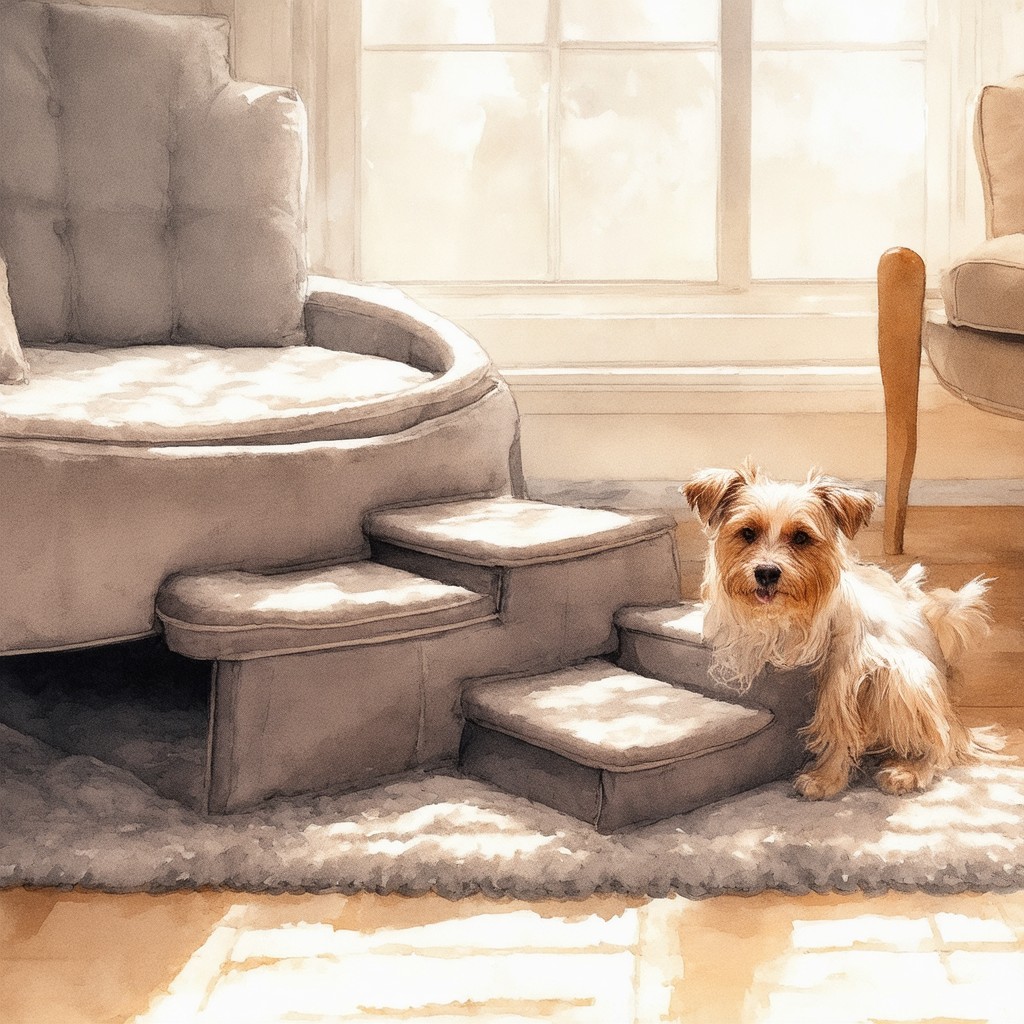Key Takeaways
- Enhanced Mobility: Pet steps improve accessibility for dogs with arthritis, allowing them to reach elevated areas without strain.
- Safety First: Using pet stairs significantly reduces the risk of falls and injuries, especially for older dogs.
- Encouragement of Independence: Pet steps empower dogs to navigate their environment freely, promoting their confidence and well-being.
- Versatile Designs: Available in various styles and materials, pet steps can blend seamlessly into your home decor while catering to your pet’s needs.
- Veterinary Endorsement: Vets recommend pet steps or ramps for dogs at risk of joint issues, enhancing their quality of life.
- Ramps vs. Stairs: Ramps are often better for dogs with arthritis due to their gentle incline, minimizing joint stress.
Choosing the right pet steps for your furry friend can significantly enhance their quality of life, especially for dogs with arthritis or mobility issues. In this article, we will explore the various options available, including the benefits of pet steps and how they improve accessibility for pets. We will also delve into the advantages of folding pet steps, discuss veterinary recommendations for dog steps, and compare alternatives like ramps and stairs. Additionally, we will address the critical question of whether a dog ramp is better than stairs for bed accessibility, particularly for dogs suffering from arthritis. By the end of this article, you will have a comprehensive understanding of how to choose the right pet steps for your home, ensuring your beloved companion can navigate their environment safely and comfortably.
What are pet steps used for?
Pet steps, also known as pet stairs or pet ramps, are designed to assist small, injured, or elderly pets in accessing elevated surfaces such as beds, couches, or vehicles. These steps provide several benefits:
- Ease of Access: Pet steps allow pets with mobility issues, such as arthritis or hip dysplasia, to reach their favorite spots without straining themselves. This is crucial for their comfort and overall well-being.
- Safety: By using pet stairs, the risk of falls and injuries is significantly reduced. Pets can navigate heights safely, which is particularly important for older animals who may have balance issues.
- Convenience: Lightweight and portable, pet steps can be easily moved from room to room or taken along when traveling. This ensures that your pet can always have access to their favorite resting places.
- Encouragement of Independence: Pet stairs promote independence in pets, allowing them to come and go as they please without needing assistance from their owners.
- Variety of Designs: Available in various sizes, materials, and designs, pet steps can fit seamlessly into your home decor while catering to the specific needs of your pet.
According to a study published in the Journal of Veterinary Behavior, providing pets with appropriate mobility aids can significantly enhance their quality of life, particularly for those with physical limitations. Investing in pet steps not only supports your pet’s physical health but also contributes to their emotional well-being by allowing them to maintain their usual routines and interactions with family members.
Understanding the Benefits of Pet Steps
Pet steps are essential for ensuring that pets, especially those with mobility challenges, can access their favorite spots comfortably. Here are some key benefits:
- Improved Quality of Life: Pet steps help pets maintain their independence, allowing them to navigate their environment without assistance. This is particularly important for older pets or those recovering from injuries.
- Reduced Stress on Joints: For pets with conditions like arthritis, using dog steps for bed or couches can minimize the strain on their joints, promoting better mobility and comfort.
- Enhanced Safety: By providing a stable and secure way for pets to reach elevated areas, pet stairs reduce the likelihood of accidents and injuries, which is crucial for older or unsteady pets.
How Pet Steps Improve Accessibility for Pets
Accessibility is a significant concern for pet owners, especially those with small dogs or pets that struggle with mobility. Pet steps improve accessibility in several ways:
- Designed for Various Heights: Pet stairs come in different heights and sizes, making them suitable for various furniture types, including beds and couches.
- Portable Options: Many pet steps are lightweight and easy to transport, allowing you to provide your pet with access to elevated areas wherever you go, whether at home or on the road.
- Customizable Features: Some pet steps offer adjustable heights or removable covers, allowing you to customize them to fit your pet’s specific needs and preferences.

Are Folding Pet Steps a Good Option?
Folding pet steps are an excellent option for pet owners, particularly those with older or mobility-challenged pets. Here are several key reasons why they are beneficial:
- Ease of Use: Folding pet steps are designed for convenience. They are lightweight and easy to store, making them ideal for homes with limited space. Many models, like the CozyUp™ Folding Pet Steps, are user-friendly, allowing pets to ascend and descend safely without assistance.
- Safety and Accessibility: These steps provide a safe way for pets to access higher surfaces, such as beds or couches, reducing the risk of injury from jumping. This is especially important for older dogs and cats, who may have joint issues or arthritis. According to a study published in the Journal of Veterinary Internal Medicine, providing pets with assistance can significantly improve their quality of life.
- Versatility: Folding pet steps can be used in various settings, whether at home or while traveling. Their portability makes them suitable for use in cars, RVs, or hotels, ensuring that your pet can always access their favorite spots.
- Durability and Design: Many folding pet steps are constructed from sturdy materials that can support pets of various sizes. Look for models with non-slip surfaces to enhance safety. Brands like PetSafe® often incorporate features that cater to both functionality and aesthetics, ensuring they fit well within your home decor.
- Positive Impact on Pet Behavior: By providing a safe way for pets to navigate their environment, folding pet steps can help reduce anxiety and stress associated with jumping or falling. This can lead to improved behavior and overall well-being, as noted by the American Kennel Club.
In conclusion, folding pet steps are a practical and beneficial investment for pet owners, particularly those with older or disabled pets. They enhance safety, accessibility, and comfort, making them a recommended choice for improving your pet’s daily life.
Advantages of Folding Pet Steps for Dogs
Folding pet steps offer numerous advantages for dogs, particularly those that struggle with mobility. Here are some key benefits:
- Space-Saving Design: The ability to fold these steps makes them easy to store when not in use, which is perfect for pet owners with limited space.
- Lightweight and Portable: Many folding pet steps are lightweight, allowing for easy transport. This is especially useful for pet owners who travel frequently or want to use the steps in different areas of the home.
- Enhanced Safety Features: Many models come equipped with non-slip surfaces and sturdy construction, ensuring that dogs can use them safely without the risk of slipping or tipping over.
- Support for Larger Breeds: Folding pet steps are available in various sizes, including options designed for large dogs, making them suitable for all breeds.
Choosing the Right Folding Pet Steps for Your Needs
When selecting folding pet steps, consider the following factors to ensure you choose the best option for your furry friend:
- Height and Width: Ensure the steps are tall enough to reach your desired surface, such as a bed or couch, and wide enough for your pet to use comfortably.
- Weight Capacity: Check the weight limit of the steps to ensure they can safely support your dog, especially if you have a larger breed.
- Material Quality: Look for durable materials that can withstand regular use. Non-slip surfaces are essential for safety.
- Ease of Assembly: Some models may require assembly, so consider how easy it is to set up and fold away.
- Customer Reviews: Reading reviews can provide insights into the effectiveness and durability of the steps, helping you make an informed decision.
Do Vets Recommend Dog Steps?
Veterinarians often recommend dog stairs or ramps for pets, particularly those at risk for back problems, such as intervertebral disc disease (IVDD). According to Dr. Steffen, a veterinarian, “We frequently advise clients with dogs prone to back issues to consider using stairs or ramps.” This recommendation is especially pertinent for breeds like Dachshunds, Pembroke Welsh Corgis, and Basset Hounds, which are anatomically predisposed to IVDD due to their long backs and short legs.
In addition to preventing injuries, dog stairs and ramps can enhance the quality of life for older dogs or those with mobility challenges. These tools help dogs access their favorite spots, such as couches or beds, without straining their joints. A study published in the Journal of the American Veterinary Medical Association highlights that maintaining mobility is crucial for a dog’s overall health and well-being.
Veterinary Insights on Dog Steps for Bed
When considering dog steps for bed, it’s essential to consult with your veterinarian to ensure the best choice for your pet’s specific needs. Dog steps for beds can significantly reduce the risk of injury, especially for older dogs or those recovering from surgery. The right dog bed stairs can provide a safe and easy way for your pet to access their sleeping area, promoting independence and comfort.
Factors to consider when selecting dog steps for bed include:
- Height and Width: Ensure the stairs are suitable for the height of your bed and your dog’s size.
- Material: Look for non-slip surfaces to enhance stability and prevent accidents.
- Weight Capacity: Verify that the stairs can support your dog’s weight, particularly for larger breeds.
The Importance of Vet Recommendations for Pet Safety
Following veterinary recommendations for pet stairs is crucial for ensuring your dog’s safety and well-being. Using dog steps can prevent unnecessary strain on their joints and back, particularly for breeds that are more susceptible to injuries. Additionally, these steps can help maintain your dog’s mobility, allowing them to enjoy their daily activities without discomfort.
For more information on improving your dog’s mobility and overall health, consult with your veterinarian or refer to resources from the American Kennel Club and the Journal of the American Veterinary Medical Association.
What are the alternatives to pet steps?
When considering alternatives to pet steps, two primary options stand out: dog ramps and dog step stools. Each has its own advantages and disadvantages, which can significantly impact your pet’s mobility and overall well-being.
Exploring Alternatives: Dog Ramps vs. Pet Steps
Dog Ramps:
- Impact-Free Movement: Unlike pet stairs, dog ramps provide a gentle incline that allows pets to ascend and descend without the repeated impacts associated with climbing stairs. This is particularly beneficial for older dogs or those with joint issues, as it minimizes stress on their joints and muscles (American Kennel Club).
- Versatility: Ramps can be used for various surfaces, including cars, beds, and couches, making them a versatile choice for pet owners. They can be adjusted in length and angle to suit different heights and spaces.
- Safety Features: Many ramps come with non-slip surfaces and side rails, enhancing safety for pets as they navigate the incline.
Dog Step Stools:
- Compact Design: Dog step stools are typically smaller and easier to store than ramps, making them a good option for limited spaces. They can be placed near furniture or vehicles for quick access.
- Affordability: Generally, dog step stools are less expensive than ramps, making them an accessible choice for many pet owners. However, they may not be suitable for all pets, especially larger breeds or those with mobility challenges.
Other Solutions for Pet Accessibility
In addition to dog ramps and step stools, there are other solutions that can enhance pet accessibility:
- Pet Steps for Cars: Specialized dog steps for cars can help pets easily enter and exit vehicles, reducing the risk of injury.
- Pet Storage Stairs: These multifunctional stairs not only assist pets but also provide storage options, making them practical for homes with limited space.
- Custom Solutions: For unique needs, consider custom-built ramps or steps that cater specifically to your pet’s size and mobility requirements.
In conclusion, while both dog ramps and step stools serve as alternatives to traditional pet steps, ramps offer a more impact-free solution that can enhance your pet’s mobility and comfort. For further insights into pet health and wellness, consider consulting resources from veterinary professionals or organizations like the ASPCA.

Is a Dog Ramp Better Than Stairs for Bed?
When deciding between a dog ramp and stairs for your pet’s access to the bed, several factors should be considered, especially for older or mobility-challenged dogs.
Comparing Dog Ramps and Stairs for Bed Accessibility
1. **Ease of Use**: A dog ramp typically features a gentle incline, making it easier for senior dogs or those with arthritis to navigate. This design minimizes the strain on their joints compared to stairs, which require more effort and can lead to potential injuries. According to a study published in the Journal of Veterinary Internal Medicine, ramps can significantly reduce the risk of joint stress in older dogs.
2. **Safety**: Ramps provide a safer option for dogs that may struggle with balance or coordination. The risk of slipping or falling is often lower with a ramp, especially if it has a non-slip surface. The American Kennel Club emphasizes the importance of safety features in pet ramps to prevent accidents.
3. **Space Considerations**: Ramps can be more space-efficient in certain environments, especially if the bed is elevated. They can be positioned at an angle that fits your room layout better than stairs, which require a specific footprint.
4. **Weight Capacity**: When selecting a ramp, ensure it can support your dog’s weight. Many ramps are designed with varying weight limits, so choose one that accommodates your pet comfortably.
5. **Training and Adaptation**: Some dogs may need time to adjust to using a ramp. Gradual training techniques, such as positive reinforcement, can help them feel more comfortable. Resources from the Association of Professional Dog Trainers suggest using treats and encouragement to facilitate this transition.
In conclusion, a dog ramp is often a better choice than stairs for older dogs or those with mobility issues due to its ease of use, safety features, and adaptability to different living spaces.
Factors to Consider When Choosing Between Ramps and Stairs
1. **Dog’s Size and Breed**: Larger breeds may benefit more from ramps, as the incline can reduce the stress on their joints. Conversely, smaller breeds might find stairs easier to navigate, especially if they are designed specifically for their size.
2. **Home Environment**: Consider your living space. If you have limited room, a ramp might fit better in tight areas. Additionally, assess the flooring type; ramps with non-slip surfaces are ideal for slippery floors.
3. **Pet’s Health**: If your dog has existing health issues, such as arthritis or hip dysplasia, ramps are generally recommended. They provide a gentler approach to accessing elevated surfaces, reducing the risk of injury.
4. **Personal Preference**: Observe your pet’s behavior. Some dogs may prefer the stability of stairs, while others might feel more secure using a ramp.
5. **Budget and Quality**: Invest in high-quality ramps or stairs that can withstand your pet’s weight and activity level. Look for options that offer durability and safety features.
For further insights on pet care and wellness, consider exploring resources from reputable organizations like the American Veterinary Medical Association.
Are Stairs or Ramps Better for Dogs with Arthritis?
When considering whether stairs or ramps are better for dogs with arthritis, it’s essential to understand the impact of mobility aids on their health and well-being. Joint health and mobility are critical factors in ensuring that our furry friends maintain a good quality of life.
The Impact of Arthritis on Dog Mobility
For dogs suffering from arthritis, the act of jumping up and down stairs can exacerbate pain and accelerate joint deterioration. Research indicates that repetitive stress on arthritic joints can lead to increased inflammation and discomfort. This is particularly concerning for larger breeds or older dogs who may already be experiencing mobility challenges. Understanding these implications is vital for pet owners looking to enhance their dog’s comfort and mobility.
Recommendations for Dogs with Arthritis: Stairs vs. Ramps
Ramps provide a gentler incline, allowing dogs to ascend and descend without the jarring impact associated with stairs. This can significantly enhance their quality of life, enabling them to access areas like vehicles or elevated surfaces with minimal strain. A study published in the Journal of Veterinary Internal Medicine highlights that ramps can reduce the risk of injury and improve mobility in arthritic dogs.
Additionally, ramps are generally easier for dogs to navigate, especially those with severe mobility issues. They can be designed with non-slip surfaces and adjustable heights to accommodate various needs, making them a versatile option for pet owners. Introducing a ramp may require some training, but positive reinforcement techniques can help dogs feel comfortable using a ramp, which can be beneficial for their mental and emotional well-being.
It’s advisable to consult with a veterinarian or a canine rehabilitation specialist to determine the best option for your dog. They can provide tailored advice based on the dog’s specific condition and mobility challenges. In conclusion, ramps are generally the better choice for dogs with arthritis, as they minimize pain and promote safer movement. By prioritizing your dog’s comfort and health, you can significantly improve their quality of life.
Choosing the Right Pet Steps for Your Home
When it comes to enhancing your pet’s mobility and comfort, selecting the right pet steps is crucial. With various options available, understanding your specific needs and your pet’s requirements can make all the difference. Here, we will explore the best choices for both indoor and outdoor settings, ensuring your furry friend can access their favorite spots with ease.
Pet Steps for Dogs: Finding the Best Fit for Your Space
Choosing dog steps for high beds or other elevated areas requires careful consideration of size, material, and design. Here are some key factors to keep in mind:
- Height and Width: Ensure the dog steps for bed are tall enough to reach the desired height while being wide enough for your pet to climb comfortably.
- Material: Look for durable materials that can withstand wear and tear. Options like wood or heavy-duty plastic are popular for their sturdiness.
- Weight Capacity: If you have a larger breed, opt for pet steps for large dogs that can support their weight without compromising safety.
- Non-Slip Features: Steps with non-slip surfaces or rubber grips can help prevent accidents, especially for older pets or those with mobility issues.
For more options, consider checking out Chewy Pet Supplies or PetSmart Official Site for a variety of dog bed stairs and pet stairs tailored to your needs.
Outdoor Pet Steps: Durable Options for Your Yard
When it comes to outdoor use, pet steps need to be robust enough to withstand the elements. Here are some considerations for selecting outdoor dog stairs:
- Weather Resistance: Choose materials that are resistant to rain, sun, and temperature changes. Plastic or treated wood options are ideal for outdoor settings.
- Stability: Ensure the steps are stable and secure, especially if they will be used on uneven ground.
- Portability: If you plan to move the steps around, lightweight designs can be beneficial.
For outdoor solutions, you might also want to explore Purina Pet Products for durable options that can enhance your pet’s outdoor experience.













